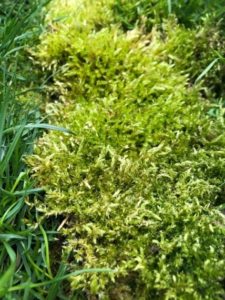
One of the most frequent lawn care problems we have been asked about in Spring is moss. Moss forms a thick mat and you may think it is choking out your grass. The truth is, the moss is not the underlying problem, it’s the lawn conditions that are the real culprit. You can attempt to remove the moss, but unless the conditions are remedied, your lawn’s overall health will not improve and the moss will return.
What are the conditions that moss loves, but grass does not? A combination of acidic, compacted soil, not enough drainage, too much shade, and lack of nutrients in the soil all contribute to the presence of moss.
What should be done to get your lawn back in shape? Let’s look at methods to remedy each condition that creates a welcome mat for moss:
Acidic soil: Acidic soils are the ideal breeding ground for moss. If a soil sample shows the soil pH is below the level recommended for your grass type, the environment is better suited for moss than grass. The grass types used most frequently in our area, including Kentucky Bluegrass, Ryegrass, and Tall Fescue – among others – prefer a pH level of 6-7. A pH balancing lime treatment will bring your soil back to a neutral, beneficial level for grass growth.
Compacted soil: Soil that is too compact does not allow for air flow, proper water drainage or nutrient uptake for grass roots. Core Aeration removes plugs of soil from the lawn and will reduce compaction. A host of other benefits are enjoyed from aeration, including improving air exchange between the soil and atmosphere, reducing runoff and puddling, creation of a stronger root system for healthy turf, and improvement of nutrient uptake. When coupled with a pH balancing treatment, aeration assists in getting lime into the soil more easily. Leaving the plugs on the lawn to break down provides beneficial nutrients to the lawn, as well, so avoid the temptation to rake them up.
Not enough drainage: Wet soil is ideal for moss. If your lawn holds water in certain low-lying areas, drainage installation may be recommended. To avoid over-watering in these areas, you may need to adjust your automatic irrigation system schedule. Watering deeply, but infrequently is the key. In these areas, you will want to avoid watering until the area really needs it or shows signs of stress.
Too much shade: Moss is more resilient in a shady environment that grass. In areas that have more shade time than sun time in a day, you may need to thin out dense branches or shrubs to allow for light to filter in. Choosing a shade resistant grass type, like a tall fescue/ryegrass blend is important, but even a shady blend cannot grow without sunlight. Allowing light in for at least four hours a day is still required. If the minimum amount of light is not an option, creating shallow mulched beds under trees is another attractive option. Avoid piling too much mulch – or you will actually collect even more moisture and block airflow to the roots.
Low nutrient levels in soil: A simple soil test will give a breakdown of the soil’s fertility. Low nutrient levels encourage moss growth and also inhibit healthy turf growth. A fertilizer program that is chosen carefully to meet your lawn’s nutrient needs will remedy infertile soil environments.
Your local Lawn Doctor can evaluate your lawn for signs of the conditions that help moss thrive and help customize a plan to get the best results. We provide all the services you need to create a healthy lawn environment – free of moss. Get started today by contacting Lawn Doctor of Strongsville-Stow to set up your free lawn care evaluation.
